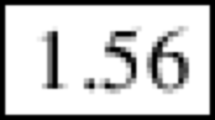Abstract
In many situations two populations are compared on the basis of subsets of the available data. If this is done using the same fraction of “best” records, then the expectations of the arithmetic means of these fractions are strictly ordered in magnitude by the ordering of the sample sizes. The results are illustrated with the special cases of the uniform and negative exponential distributions, for which further inequalities are derived.
Similar content being viewed by others
References
Adamovié, D. D. and Taskovié, M. R. (1969). Monotony and the best possible bounds of some sequences of sums, Publikacije Elektrotehničkog Fakulteta Univerziteta u Beogradu, Serija: Matematika i Fizika, No. 247-3, 41–50.
Beckenbach, E. F. and Bellman, R. (1961). Inequalities, Springer, Berlin.
Becker, W. A. (1968). Manual of Procedures in Quantitative Genetics, Washington State University Press, Pullman, Washington.
Burrows, P. M. (1972). Expected selection differentials for directional selection, Biometretrics, 28, 1091–1100.
Burrows, P. M. (1975). Variances of selection differentials in normal samples, Biometrics, 31, 125–133.
David, H. A. (1981). Order Statistics, 2nd ed., Wiley, New York.
Feller, W. (1971). An Introduction to Probability Theory and Its Applications, Vol. II, 2nd ed., Wiley, New York.
Gillett, R. (1989). A sampling artifact in the UGC evaluation of research performance, Bri. J. Math. Statist. Psych., 42, 127–132.
Harter, H. L. (1961). Expected values of normal order statistics, Biometrika, 48, 151–159.
Mitrinovié, D. S. (1970). Analytic Inequalities, Springer, Berlin.
Nagaraja, H. N. (1981). Some finite sample results for the selection differential, Ann. Inst. Statist. Math., 33, 437–448.
Nagaraja, H. N. (1982). Some nondegenerate limit laws for see selection differential, Ann. Statist., 10, 1306–1310.
Nagaraja, H. N. (1984). Some nondegenerate limit laws for sample selection differential and selection differential, Sankhyã Ser. A, 46, 355–369.
Schaeffer, L. R., VanVleck, L. D. and Velasco, J. A. (1970). The use of order statistics with selected records, Biometrics, 26, 854–859.
Sillitto, G. P. (1964). Some relations between expectations of order statistics in samples of different sizes, Biometrika, 51, 259–262.
Author information
Authors and Affiliations
About this article
Cite this article
English, B.J., Gillett, R. & Phillips, M.J. Inequalities concerning the expected selection differentials. Ann Inst Stat Math 44, 169–175 (1992). https://doi.org/10.1007/BF00048679
Received:
Revised:
Issue Date:
DOI: https://doi.org/10.1007/BF00048679




